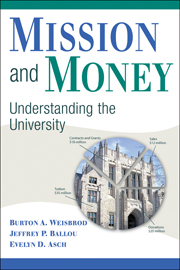Book contents
- Frontmatter
- Contents
- Illustrations
- Preface
- 1 An Introduction to the Higher Education Industry
- 2 The Higher Education Business and the Business of Higher Education – Now and Then
- 3 Is Higher Education Becoming Increasingly Competitive?
- 4 The Two-Good Framework: Revenue, Mission, and Why Colleges Do What They Do
- 5 Tuition, Price Discrimination, and Financial Aid
- 6 The Place of Donations in Funding the Higher Education Industry
- 7 Endowments and Their Management: Financing the Mission
- 8 Generating Revenue from Research and Patents
- 9 Other Ways to Generate Revenue – Wherever It May Be Found: Lobbying, the World Market, and Distance Education
- 10 Advertising, Branding, and Reputation
- 11 Are Public and Nonprofit Schools “Businesslike”? Cost-Consciousness and the Choice between Higher Cost and Lower Cost Faculty
- 12 Not Quite an Ivory Tower: Schools Compete by Collaborating
- 13 Intercollegiate Athletics: Money or Mission?
- 14 Mission or Money: What Do Colleges and Universities Want from Their Athletic Coaches and Presidents?
- 15 Concluding Remarks: What Are the Public Policy Issues?
- Appendix
- References
- Index
10 - Advertising, Branding, and Reputation
Published online by Cambridge University Press: 17 July 2009
- Frontmatter
- Contents
- Illustrations
- Preface
- 1 An Introduction to the Higher Education Industry
- 2 The Higher Education Business and the Business of Higher Education – Now and Then
- 3 Is Higher Education Becoming Increasingly Competitive?
- 4 The Two-Good Framework: Revenue, Mission, and Why Colleges Do What They Do
- 5 Tuition, Price Discrimination, and Financial Aid
- 6 The Place of Donations in Funding the Higher Education Industry
- 7 Endowments and Their Management: Financing the Mission
- 8 Generating Revenue from Research and Patents
- 9 Other Ways to Generate Revenue – Wherever It May Be Found: Lobbying, the World Market, and Distance Education
- 10 Advertising, Branding, and Reputation
- 11 Are Public and Nonprofit Schools “Businesslike”? Cost-Consciousness and the Choice between Higher Cost and Lower Cost Faculty
- 12 Not Quite an Ivory Tower: Schools Compete by Collaborating
- 13 Intercollegiate Athletics: Money or Mission?
- 14 Mission or Money: What Do Colleges and Universities Want from Their Athletic Coaches and Presidents?
- 15 Concluding Remarks: What Are the Public Policy Issues?
- Appendix
- References
- Index
Summary
Brand names are assets to any firm or organization. Colleges and universities, whether public, private nonprofit, or for-profit, are no different. Those that have national name recognition can attract a broader and more talented pool of applicants, more tuition revenue, and more donations.
Because a strong reputation often shows that the college or university has been successful in pursuit of its mission, a reputation once developed is a potential revenue good that can be profitably exploited. Somewhat ironically, it is the school's reputation for its unprofitable activities, such as research and many elements of instruction, that often permits it to make profits in other activities. For example, by lending its good name to other revenue-raising programs – such as continuing education or product certification or endorsements – a school can expect to enhance its revenue. Critical to success in higher education, however, is the perception that the school's primary priority and mission is the welfare of the student and the production and dissemination of knowledge and not merely money. Overexploiting the brand name can result in greater short-run revenues at the expense of long-run reputation, as happened when Johns Hopkins University decided to endorse skin care products for cash (see Chapter 12). Thus, “successful” brand management involves a trade-off between leveraging the brand – making use of it to generate revenue – and simultaneously sustaining its value. A public or nonprofit college or university is very much like a private firm in facing this continued balancing problem.
- Type
- Chapter
- Information
- Mission and MoneyUnderstanding the University, pp. 175 - 195Publisher: Cambridge University PressPrint publication year: 2008

